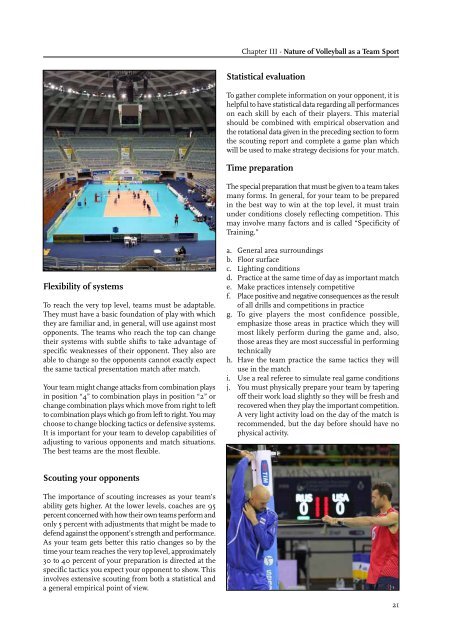COACHES MANUAL
Download
Download
- No tags were found...
You also want an ePaper? Increase the reach of your titles
YUMPU automatically turns print PDFs into web optimized ePapers that Google loves.
Chapter III - Nature of Volleyball as a Team Sport<br />
Statistical evaluation<br />
To gather complete information on your opponent, it is<br />
helpful to have statistical data regarding all performances<br />
on each skill by each of their players. This material<br />
should be combined with empirical observation and<br />
the rotational data given in the preceding section to form<br />
the scouting report and complete a game plan which<br />
will be used to make strategy decisions for your match.<br />
Time preparation<br />
The special preparation that must be given to a team takes<br />
many forms. In general, for your team to be prepared<br />
in the best way to win at the top level, it must train<br />
under conditions closely reflecting competition. This<br />
may involve many factors and is called “Specificity of<br />
Training.”<br />
Flexibility of systems<br />
To reach the very top level, teams must be adaptable.<br />
They must have a basic foundation of play with which<br />
they are familiar and, in general, will use against most<br />
opponents. The teams who reach the top can change<br />
their systems with subtle shifts to take advantage of<br />
specific weaknesses of their opponent. They also are<br />
able to change so the opponents cannot exactly expect<br />
the same tactical presentation match after match.<br />
Your team might change attacks from combination plays<br />
in position “4” to combination plays in position “2” or<br />
change combination plays which move from right to left<br />
to combination plays which go from left to right. You may<br />
choose to change blocking tactics or defensive systems.<br />
It is important for your team to develop capabilities of<br />
adjusting to various opponents and match situations.<br />
The best teams are the most flexible.<br />
a. General area surroundings<br />
b. Floor surface<br />
c. Lighting conditions<br />
d. Practice at the same time of day as important match<br />
e. Make practices intensely competitive<br />
f. Place positive and negative consequences as the result<br />
of all drills and competitions in practice<br />
g. To give players the most confidence possible,<br />
emphasize those areas in practice which they will<br />
most likely perform during the game and, also,<br />
those areas they are most successful in performing<br />
technically<br />
h. Have the team practice the same tactics they will<br />
use in the match<br />
i. Use a real referee to simulate real game conditions<br />
j. You must physically prepare your team by tapering<br />
off their work load slightly so they will be fresh and<br />
recovered when they play the important competition.<br />
A very light activity load on the day of the match is<br />
recommended, but the day before should have no<br />
physical activity.<br />
Scouting your opponents<br />
The importance of scouting increases as your team’s<br />
ability gets higher. At the lower levels, coaches are 95<br />
percent concerned with how their own teams perform and<br />
only 5 percent with adjustments that might be made to<br />
defend against the opponent’s strength and performance.<br />
As your team gets better this ratio changes so by the<br />
time your team reaches the very top level, approximately<br />
30 to 40 percent of your preparation is directed at the<br />
specific tactics you expect your opponent to show. This<br />
involves extensive scouting from both a statistical and<br />
a general empirical point of view.<br />
21



